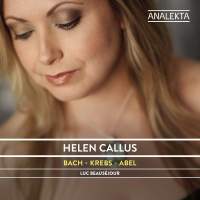Texte paru dans: / Appeared in: |
|
|
Outil de traduction ~ (Très approximatif) |
|
|
Reviewer: Carla
Maria Verdino-Süllwold This sprightly collection of 18th-century music for viola da gamba (here adapted to the viola) and harpsichord focuses on the compositions of Bach and his circle in Leipzig. Violist Helen Callus and harpsichordist Luc Beauséjour have assembled five works by three composers, whose lives intertwined in Leipzig in the years around 1735. The exact intersections of the careers of Bach, Carl Friedrich Abel, and Johann Krebs are uncertain, nor is it clear if they were ever all in Leipzig at the same time; but they did share family and professional ties, and their music bespeaks considerable affinities, all of which make for a pleasing recital. Callus’s adaptations of the viola da gamba sonatas for her own instrument, the viola (rather than the frequently heard cello), work extremely well, and her mastery of her instrument is well known. She plays here with a supple, dark, rich tone, a luxurious line, and an agile facility for ornamentation. Beauséjour proves a strong partner on the harpsichord, playing with nuance, texture, rhythmic grace, and expressivity. The two musicians blend their voices elegantly and effectively, making the compositions true duets. There is an overall energy and vitality to the duo’s performances that captures the listener from start to finish. Of the five selections, Bach’s three sonatas for viola da gamba and harpsichord are the more interesting works—inventive melodically and harmonically and played here with insight and identification by the soloists. His use of the harpsichord as an equal voice makes for a dynamic chamber music experience. Particularly memorable is the jaunty Allegro from Sonata No. 2 and the Adagio from Sonata No. 3. The Andante from Krebs’s Trio in C Minor (adapted here for one harpsichord) is an accomplished if less textured or complex work, and Abel’s Sonata No. 2 in E Minor, written late in his career in 1782, offers some felicitous moments, especially in the opening Siciliano and the closing Presto.
Recorded at Quebec’s Eglise de
St. Augustin-de-Mirabel, the disc’s sound is extremely vivid, and the
balance most complementary. The booklet includes biographies and a short
program note. Especially recommended for Bach devotees and fans of the viola
and harpsichord. | |
|
|
|
|
Cliquez l'un ou l'autre
bouton pour découvrir bien d'autres critiques de CD |
|




